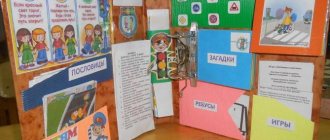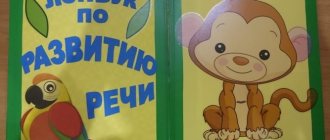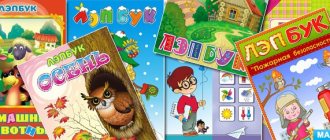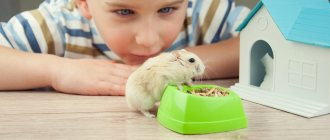Lapbook “Pets”
Prokofieva Irina Olegovna teacher, MBDOU kindergarten No. 6 combined type, Belgorod
The material was sent to the ongoing professional competition for teachers of preschool educational institutions “Lapbook - a fun development technology.”
Information sheet Lapbook “Pets”
Relevance of the problem:
- The laptop is a new learning tool.
Advertising message
With the introduction of the Federal State Educational Standard, every preschool teacher is in constant search for new forms of organizing educational activities. A laptop is a wonderful find for a teacher. This type of benefit appeared relatively recently in our country, but its popularity is only growing.
Literally translated, the term “lapbook” is “a book on your lap.” That is, it is a thematic folder with many pockets and windows in which material on a specific topic is collected. It is recommended to do this benefit together with children and parents. The value of such a folder for each child increases.
And parents have the opportunity to spend even more time with their child.
Problem:
A significant decrease in the cognitive activity of children; the need for independent knowledge of the surrounding reality is not sufficiently formed.
I present to your attention a lapbook on the topic “Pets”.
Goal: to arouse interest in the topic being studied, increase curiosity, attract children to individual and joint activities under the guidance of an adult.
Tasks:
- Educational: expand and consolidate children’s knowledge about domestic animals and their cubs (what they eat, where they live, what benefits they bring, distinguish by external features and structure);
- Developmental: develop gross motor skills, coordination, visual and auditory memory; develop coherent speech; develop children's verbal and logical thinking;
- Educational: cultivate a love for pets.
Age: For children 5-6 years old.
A laptop for preschoolers is an amazing and very useful guide that has gained popularity in our country relatively recently. This manual helps you quickly and effectively learn new information and consolidate what you have learned in an entertaining and playful way. The laptop is multifunctional; it consists of several games that serve a specific purpose. It’s especially nice to make a lapbook with your own hands.
A laptop can be used in educational activities, as well as in special moments, for joint and individual activities. It is a thematic interactive folder with various pockets and curly envelopes.
The design of the lapbook includes: a rotating circle, pockets, cut and whole plot pictures, flat images of animals, a “folding” book.
Lapbook includes:
- Cutting pictures: “Find the difference”
Goal: continue to develop the ability to compare objects, establish their similarities and differences (how these objects are similar and how they differ, etc.).
- Pocket with riddles: “Riddles about animals”
Goal: to develop cognitive interest, auditory perception and thinking of children.
- Pocket: “Coloring books.”
Goal: development of visual perception, attention, logical thinking.
- Rotating circle: “Who eats what?”
Goal: consolidate knowledge on topics, create conditions for activating the child’s vocabulary on these topics, develop the ability to analyze, consolidate the ability to distinguish and name animals, and develop fine motor skills.
- D/i “Who lives where?”
Goal: development of children's visual perception, attention, logical thinking.
- Pocket “Story pictures”
Goal: to form in children an idea of a holistic image, to teach children to compose descriptive stories about pets, using a plan.
- Pocket: “Whose baby?”
Goal: to consolidate children's knowledge of naming domestic animals and their babies.
- Envelopes: “What benefits do they bring?”
Goal: To enrich the vocabulary on the topic, to introduce words into the children’s dictionary that will be new to them.
- Pocket: “Cut pictures”
Goal: to introduce children to different parts of the animal body.
- Pocket: “Learn to count”
Goal: to develop the grammatical structure of speech, to learn to coordinate nouns with numerals.
This lapbook is a great way to review and consolidate the material you have covered. At any convenient time, the child simply opens the laptop and happily repeats what he has learned, looking at the pictures and completing tasks.
As a result, children will know the names of domestic animals and their babies; they learn that a person cares for domestic animals (feeds, waters, treats, washes, protects, grazes); They will also know what pets eat and what benefits pets bring to people; children will use the names of domestic animals and their cubs in speech, solve riddles, and will love and care for their pets.
MAGAZINE Preschooler.RF
Methodological manual for children of the second younger group. Lapbook "Pets".Completed by: Kharavinkina I.I. MBDOU "Atamanovsky kindergarten" of a combined type. 2019-2020
With the introduction of the Federal State Educational Standard, every preschool teacher is in constant search for new forms of organizing educational activities. A laptop is a wonderful find for a teacher. This type of benefit appeared relatively recently in our country, but its popularity is only growing.
Literally translated, the term “lapbook” is “a book on your lap . That is, it is a thematic folder with many pockets and windows in which material on a specific topic is collected. It is recommended to do this benefit together with children and parents. The value of such a folder for each child increases.
And parents have the opportunity to spend even more time with their child.
Problem:
A significant decrease in the cognitive activity of children; the need for independent knowledge of the surrounding reality is not sufficiently formed.
I present to your attention a lapbook on the topic “Pets” .
Goal: to arouse interest in the topic being studied, increase curiosity, attract children to individual and joint activities under the guidance of an adult.
Tasks:
- Educational: expand and consolidate children’s knowledge about domestic animals and their cubs (what they eat, where they live, what benefits they bring, distinguish by external features and structure);
- Developmental: develop gross motor skills, coordination, visual memory; develop coherent speech; develop children's verbal and logical thinking;
- Educational: cultivate a love for pets.
Age: For children 3-4 years old.
A laptop for preschoolers is an amazing and very useful guide that has gained popularity in our country relatively recently. This manual helps you quickly and effectively learn new information and consolidate what you have learned in an entertaining and playful way. The laptop is multifunctional; it consists of several games that serve a specific purpose. It’s especially nice to make a lapbook with your own hands.
A laptop can be used in educational activities, as well as during routine moments, for joint and individual activities. It is a thematic interactive folder with various pockets and curly envelopes.
The design of the lapbook includes: a rotating circle, pockets, cut and whole plot pictures, and flat images of animals.
Lapbook includes:
1. Pocket “Labyrinth”
Goal: development of fine differentiated movements of the fingers, visual-spatial orientation on a sheet of paper.
2. Pocket “Think whose footprints these are”
Goal: To be able to distinguish traces of domestic animals, to develop observation, attention, logical thinking, and speech in children.
3. Cut-out pictures: “Puzzles”
Goal: To teach the perception of a holistic image; develop attention and perseverance.
4. Pocket: “Complete the animal .
Goal: development of visual perception, attention, logical thinking.
5. D/i. circle: “Who eats what?”
Goal: consolidate knowledge on the topic, create conditions for activating the child’s vocabulary on this topic, develop the ability to analyze, consolidate the ability to distinguish and name animals, and develop fine motor skills.
6. D/i. "Tell me about your pet"
Goal: to form in children an idea of a holistic image, to teach children to compose descriptive stories about pets, using a plan.
7. Pocket: “Whose baby?”
Goal: to consolidate children's knowledge of naming domestic animals and their babies.
8. D/i “Find the shadow”
Goal: development of children's visual perception, attention, logical thinking.
9. Pocket: “What benefits do they bring?”
Goal: To enrich the vocabulary on the topic, to introduce words into the children’s dictionary that will be new to them.
10. Pocket: “Find a family”
Goal: to consolidate children’s ideas about domestic animals and their cubs, as well as to form the concept of “Family”.
This lapbook is a great way to review and consolidate the material you have covered. At any convenient time, the child simply opens the laptop and happily repeats what he has learned, looking at the pictures and completing tasks.
As a result, children will know the names of domestic animals and their babies; they learn that a person cares for domestic animals (feeds, waters, treats, washes, protects, grazes); They will also know what pets eat and what benefits pets bring to people; children will use the names of domestic animals and their cubs in speech, and will love and care for their pets.
| Next > |
Author's didactic manual laptop “Wild animals of central Russia”
Preschool children are just beginning to get acquainted with the world around them: with the laws of nature, animals and plants. And a lot of work on environmental education falls on kindergarten workers. Everything is important: to design the group, the territory of the kindergarten, organize a corner of nature and carry out systematic work to introduce children to the world around them. How to do it? Teachers are constantly looking for new forms of working with children in this area. One of the effective and interesting forms of work is the design of a thematic folder - a laptop. This form is the most effective, especially in terms of environmental education of children. It is also good to involve parents in joint work on the design of a thematic folder. A laptop (thematic interactive folder) is a homemade folder with a different set of materials on a specific topic. All materials from the laptop are located in various windows and pockets, so that the child can take it out, move it, play, look at it, and complete tasks.
Making a laptop “Wild Animals of Central Russia” for children 5-6 years old was the final stage of the thematic week on the topic “Wild Animals”.
Goal: expanding knowledge about forest animals, comparing them by appearance, feeding patterns, giving an idea of the place of each animal in the natural community and the relationship with the habitat and with each other.
Tasks:
— consolidate children’s knowledge about some distinctive features in the behavior of wild animals and their appearance;
— consolidate the ability to generalize previously acquired knowledge and draw conclusions based on it;
— expanding the vocabulary on the topic, developing general speech skills;
— consolidate skills in the formation of grammatical structure of speech;
- develop thinking, visual and auditory attention;
- to develop an interest in living nature;
— to educate children to respect nature, to teach them to empathize with our smaller brothers.
The “Wild Animals” laptop is made from a cardboard box. All the material is laid out in various pockets and envelopes, which are all labeled and pictures are glued to guide the children. A child can make up a story based on a picture, color various animals, put together a picture, play various educational games, and use drawing diagrams.
The thematic folder includes tasks for children such as:
The didactic game “Assemble a picture” will help in developing the thinking of holistic perception, children’s attention, the ability to assemble a whole from parts and consolidating knowledge about wild animals.
Didactic game “Whose home?” The game consists of pictures depicting the homes of wild animals and the animals themselves. Children put
a picture of a dwelling under a picture with the corresponding animal. The game helps expand children's horizons about wild animals, clarify the names of dwellings, and activate their vocabulary.
In the pocket with the game “Whose Shadow?” there are shadows of animals cut out of black cardboard. Children need to determine which animal the shadow belongs to. The purpose of this game is to develop logic, thinking and visual memory. Children also use them as stencils for drawing.
In the “Rebuses, crosswords” pocket, children will find a lot of puzzles and various interesting puzzles and tasks.
In the notebook, children will find riddles about wild animals. They can check the correctness of the answer by looking at the picture.
Lotto “Where, whose footprint and who eats what” will help clarify and consolidate children’s knowledge about wild animals and their way of life; introduce the concept of “traces”, introduce the types of tracks of wild animals, develop the ability to correlate an animal with the tracks it leaves; consolidate children's ideas about the food of wild animals, develop logical thinking, imagination, and coherent speech.
The “Tell Me” pocket contains cards with didactic games on cognitive and speech development, which help replenish and activate children’s vocabulary by deepening children’s knowledge about wild animals; to form a sound culture of speech; develop the ability to use in speech the most common adjectives, verbs, prepositions, as well as diagrams for composing a story about wild animals, according to which children learn to compose a description story about an animal based on a plan diagram.
Pocket “Look and Color.” The process of coloring illustrations teaches children perseverance and neatness. Coloring books also develop aesthetic taste and instill a love of art. They develop mental and creative abilities, children begin to use their own imagination more actively. Coloring books help to cultivate perseverance, teach endurance, accuracy and attentive work. Children learn to focus attention, and this will certainly be needed at school.
Didactic game “Whose tail?” There are wild animals in the pocket, as well as their tails, you need to help the animals find their tails. The goal of the game is to consolidate knowledge about animals, develop memory, thinking, attention and fine motor skills.
The little book “Writers about Animals” contains poems, fairy tales, stories about animals with illustrations.
The album “About Animals”, which describes the features of the appearance, behavior of the animal and their living conditions with bright illustrations.
Thus, we can say that a laptop is a collective image of a poster, book and handouts, which is aimed at developing creative potential within the framework of a given topic, expanding not only one’s horizons, but also developing skills and abilities.
Making lapbooks “Our Pets” project on the world around us (preparatory group)
During the implementation of the educational project “Our Pets,” thematic lapbooks were made with the students.
The topic was not chosen by chance, because in our time much attention is paid to the formation of the foundations of environmental culture. And when communicating with pets, the child learns to show a careful and caring attitude towards the animal world as a whole.
Few people think that pets can help parents raise their children. Meanwhile, a pet can become a child’s very first, best and most devoted friend, comprehensively developing the child’s abilities.
Pets help children learn about the world, because for a child, animals are part of the unknown world. After talking with your pet, your child will want to know more about him and his world. By watching your pet every day, the child becomes inquisitive and observant. And if parents entrust their child with caring for an animal, then the child learns discipline, independence and responsibility, which will definitely be useful to him in later life.
During the creation of lapbooks, children acted almost entirely independently, with little help. I suggested the theme of the lapbook - “Our Pets”, small blanks (templates), and the children independently filled out their creative folder at their own discretion. The creation of the folder occurred gradually, in several stages as new material was mastered. After finishing the work, the folder remained with the child, which allowed him to open it at any time, recall it in his memory and tell his peers and parents all the knowledge that he gained while learning about this topic and creating a lapbook.
At the regional methodological association, I, together with the pupils of the preparatory school group “Fairy Tale” Matvey, Vlada and Valeria, presented laptops on the topic: “My Pets”. Each of the children independently spoke about their lapbook and the work they did in preparing the manual and collecting information about their beloved pet.
Matvey spoke about dogs, the variety of breeds, their external characteristics and habits, methods of care and much more. All this information is colorfully presented in his lapbook “All About Dogs.”
Vlad introduced her to her favorite cat. Her lapbook “Cats” contains a variety of educational material about various breeds of cats, how people tamed cats, what benefits a cat brings to a person, what it eats and how to care for a pet. All information is presented in the original form: pockets with pictures, baby books, folding books, cut-out pictures, coloring books, riddles, etc.
Lera shared her dream of a goldfish, which is not yet in her aquarium. She made her lapbook in the form of an aquarium, in which there are many pictures, games, stories and riddles about aquarium fish. Lera talked about goldfish, their habits, external signs, what to feed them and how to care for the aquarium.
The children's stories were informative, logical, interesting and expressive. Each child showed not only knowledge, but also a caring, touchingly caring attitude towards their pets.
What are the benefits of laptops?
Lapbooks develop cognitive activity and independence; develops the ability to actively interact with peers. This is also a great way to review what you have learned. At any convenient time, the child simply opens the laptop and happily repeats what he has learned, looking at the book he made with his own hands. The effective use of this educational technology has led to clear positive changes in the cognitive development of children and to the personal growth of preschoolers. The pupils’ speech became richer and their vocabulary expanded.
Thus, we see that the Lapbook method is relevant and very effective. Using this method, the child’s subjective position is formed, his individuality is revealed, interests and needs are realized, which in turn contributes to the child’s personal development. And this corresponds to the social order at the present stage.
I present one of the lapbooks.
Lapbook “All about dogs”
The manual is intended for independent and joint activities of children of senior preschool age.
Goal: To clarify and expand children’s knowledge about a pet – a dog (their lifestyle, habits); strengthening the rules of safe behavior when handling animals; stimulating manifestations of kind feelings towards the animal; promoting the accumulation of personal experience of knowledge of the surrounding world and sensory contact with it.
Didactic games and tasks
- "Dog breeds"
Material: Cards of the most popular dog , their names. These cards can be used not only for introductory display, but also hand out cards to children and ask them to tell about “your pet” or say what is the same for all dogs and what is different.
There are about 400 dog breeds in the world and they are all different from each other. There are simply giants, and there are real crumbs.
We included in the lapbook such breeds as: Bulldog, German Shepherd, Poodle, Labrador, Dachshund, Husky, Chihuahua. The smallest dog in the world is the Chihuahua. Its weight is no more than 2 kg. The smallest one was the size of a Coca-Cola can.
- "The Structure of a Dog"
Material: Picture “Structure of a dog” (plane image)
- "Interesting facts about dogs"
Material: A little book containing interesting facts about dogs.
- Dogs understand up to 250 words and gestures, count to five and can solve simple math problems. Intellectually they are at the level of two-year-old children.
- In Russia, dogs were able to adapt the subway to their needs: they learned to ride public transport in search of food, traveling through the most populated areas.
- Dogs can distinguish ultrasonic whistles.
- In ancient China, the emperor's last line of defense was a small Pekingese dog: it hid in his sleeve and, in case of danger, jumped out and rushed at the enemy.
- The dog needs a wet nose to determine the direction of the smell.
- Spike collars were invented in ancient Greece to protect dogs' necks from wolf attacks.
- If your dog smells like chips, this does not mean that he ate your stash, do not rush to scold him. There's a phenomenon called "Frito Feet" where bacteria buildup on paws can cause them to smell like corn chips. The reason is non-compliance with hygiene rules after a walk.
- "Dogs on the screen»
Material: Pictures depicting Soviet and foreign cartoons with dogs . These cards can be used to describe cartoons.
5. Game “What should a dog have at home?”
Material: Inertial circle. Children are asked the question: “What should you take for a walk with your dog ?” or “What should a dog have at home ?” Children show their choices with arrows.
- Game "Find the owner"
Material: Cards of people (owners) and dogs. They are very similar to each other. These pictures correspond to the principle “from simple to complex.” Offer the child a picture of one dog, ask him to choose a picture of a person (owner) who is as similar to it as possible, and then explain his choice (how they are similar).
- Lotto "Dog Breeds"
Material: Cards with pictures of dogs. Invite your child to find the breed from the picture.
- “A story based on pictures”
Material: Scene pictures with dogs. Invite your child to write a story.
9. «Dogs are astronauts"
Material: Pictures of dogs that have been in space.
- "Coloring"
Material: Envelope with coloring pages on the theme “Dogs”. Children color pictures with colored pencils and felt-tip pens.
- “Rules for safe behavior when meeting an unfamiliar dog”
Material: Picture with rules of conduct.
- Don't show your dog your fear. She may sense this and act aggressively.
- Don't make eye contact with an unfamiliar dog.
- Don't run away from the dog
- Never touch dogs while they are eating or sleeping. Don't touch the puppies.
Lapbooks on the topic “Pets, birds and pets”
Contained in sections:
- Pets. All materials 3940
- Poultry. Poultry yard 926
- Lapbook. Lapbooks on all topics 7430
Showing publications 1-10 of 116. All sections | Pets and birds. Lapbook
New
Photo
The best
Lapbook “Pets”
From early childhood it is important to introduce children to pets . Talk about their characteristics and care, cultivate a love for pets and a desire to care for them. Understand that animals are an integral part of wildlife . Not all parents have the opportunity to...
Lapbook “Who eats what” in the first junior group “Domestic and wild animals”
Lapbook “Who eats what”
made to consolidate the material covered on cognitive development (familiarization with the environment.
The lapbook can also be used as a didactic game during individual lessons with children. The task of such a lapbook is to consolidate and…







